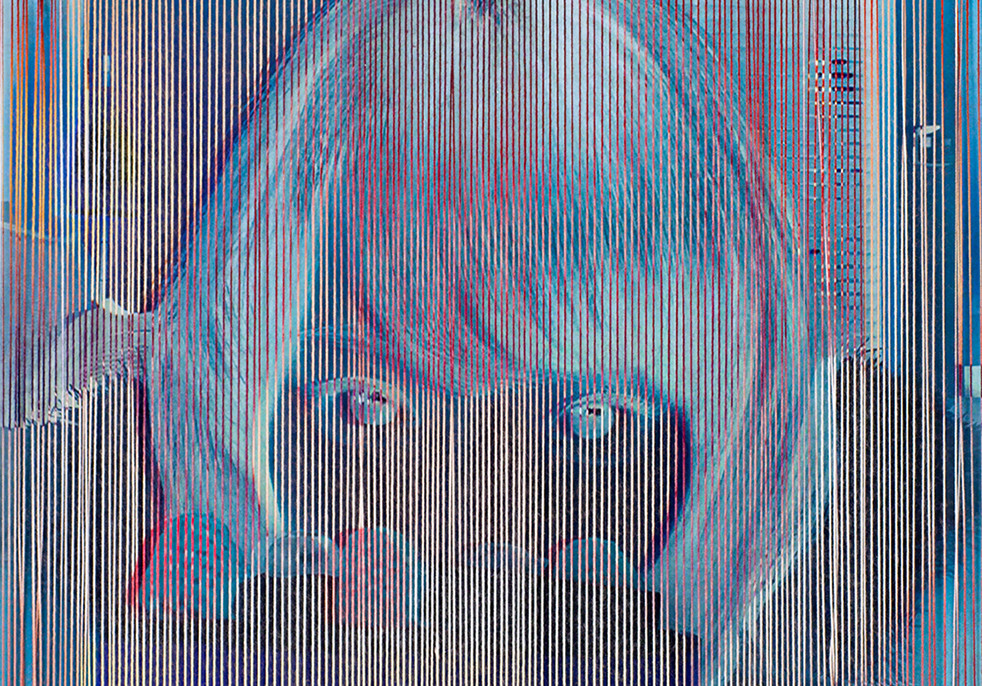
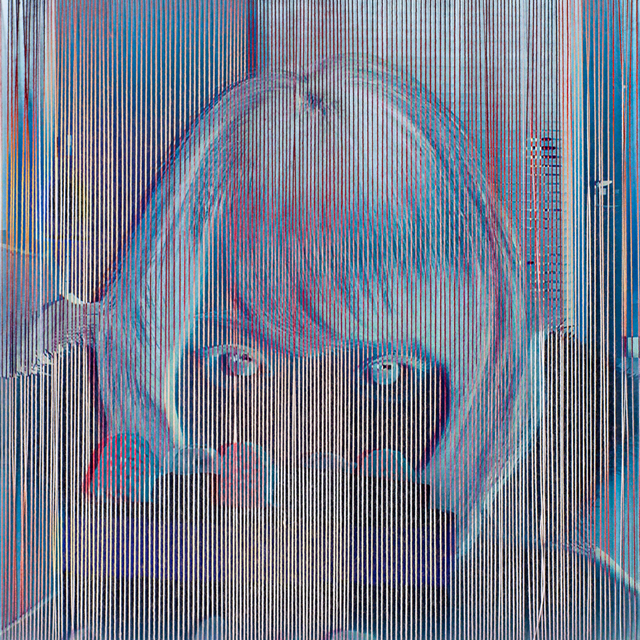
©asamikiyokawa
Artist: 清川あさみ Asami Kiyokawa Title: 1:1 Date: 2016 Material:
sublimation transfer printing / thread / ink on paper Size: image:
30×30cm frame: 30×30cm
EXHIBITION
INFORMATION
展覧会情報
虚飾に満ち、綻びた日常の表面を「感覚の糸」で縫い、
つなぐことで、もう一度「私」や「あなた」のこととして確かめたい
清川あさみ15周年新作個展「ITOTOITO」
2016年4月2日(土) - 2016年5月25日(水)
11時 - 20時
EYE OF GYRE/GYRE 3F
東京都渋谷区神宮前5-10-1 T/03-3498-6990
共催 : GYRE/ASAMI
協賛 : 富士アクリル工業
協力 : 株式会社 細尾/ippudo Inc./HiRAO INC
清川あさみ 作家活動15周年によせて各界の方々100名にコメントをいただきました
100 COMMENTS ABOUT 15TH ANNIVERSARY
1 : 1
作家本人のインスタグラムにアップされた画像のネガポジを反転させ、片方のイメージは写真紙に、もう片方は縦糸だけを連ねた面に転写します。二つのレイヤーを少し離して重ね合わせると、見る角度によってネガティヴとポジティヴのイメージが競い合い、その時の記憶や心理の背景にあるものが複層的に表現されます。
協賛:富士アクリル
The artist combines positive and negative versions of images she
posted on Instagram, printing one onto photo paper, and the other
onto a plane of warp threads. The two images are superimposed,
leaving a small gap between the layers. Viewed from some angles, the
negative and positive versions clash, producing a multi-layered
expression of the psychological background and memories of the time
when the posting was made.
Sponsored by FujiAcrylic

©asamikiyokawa
Title: 1:1 Date: 2016
わたしたちのおはなし
作家が所有する本のなかで、特に思い入れのある100冊の印象的なページに刺繍でドローイングしています。過去の記憶をひとつずつ編み込むように、物語の糸は紡がれます。そして、糸と糸は繋がり合い、私たちのなかでもうひとつの物語へと変化するのです。
Our Story
From her own collection, the artist selected 100 books that she has fond memories of, and produced embroidered drawings on pages that had left a particularly strong impression. The threads of the stories are gathered as if braiding old memories together one by one. As the individual threads connect, they transform into another story inside us.
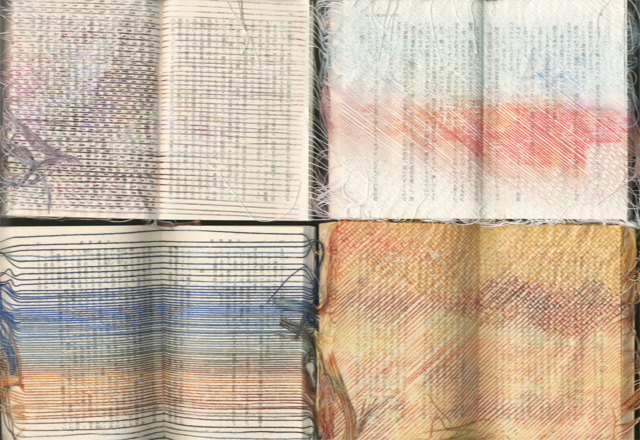
©asamikiyokawa
Title: 私達のお話 Date: 2016
タペストリー
現代版TOKYO MONSTER。ファッション誌のスナップ写真を様々な糸を組み合わせて織り上げ、モンスターたちが東京の風景に混じり合い、曖昧になっていく様子を表現します。情報が溢れ混沌とした雰囲気が漂うなか、生きる喜びや目的を見出すために、彼らは当てのない旅を続けています。
協力:細尾
Tapestry
A present-day version of TOKYO MONSTER. By taking snaps from
fashion magazines and weaving them together with many different
threads, the monsters blend in with the Tokyo scenery, evoking the
growing ambiguity and obscurity of the subjects. In today’s chaotic
atmosphere of information overload, young people keep on making
aimless journeys in the hope of finding an objective or discovering
the joy of life.
With cooperation from HOSOO
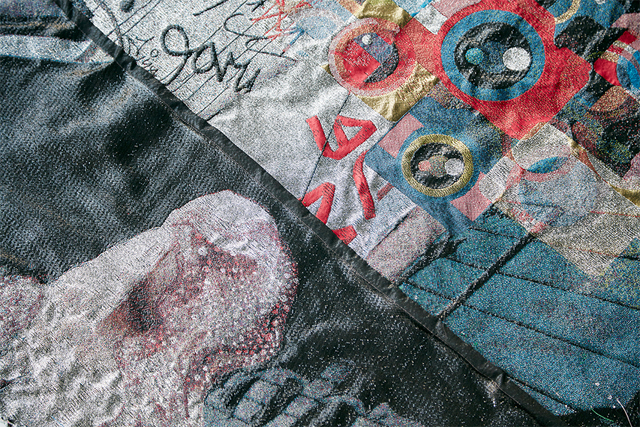
©asamikiyokawa
Title: タペストリー Date: 2016
TOKYO MONSTER
いつの時代でも、なぜ人は自分の容姿を飾りたがるのでしょう。90年代のファッション誌のスナップ写真をモチーフ(その頃、作家本人も読者モデルをしていた)として、東京を彷徨う若者たちの心の中にあるコンプレックスや虚栄心の表れを「モンスター」になぞらえて表現します。
提供:FRUiTS
People have always wanted to adorn themselves to change their appearance. To investigate why, the artist adopted as motifs street snaps from a fashion magazine of the 1990s, a time when she herself appeared as such an amateur model. Manifesting the complexes and vanities in the hearts and minds of the young people on the Tokyo streets, she likens them to monsters.
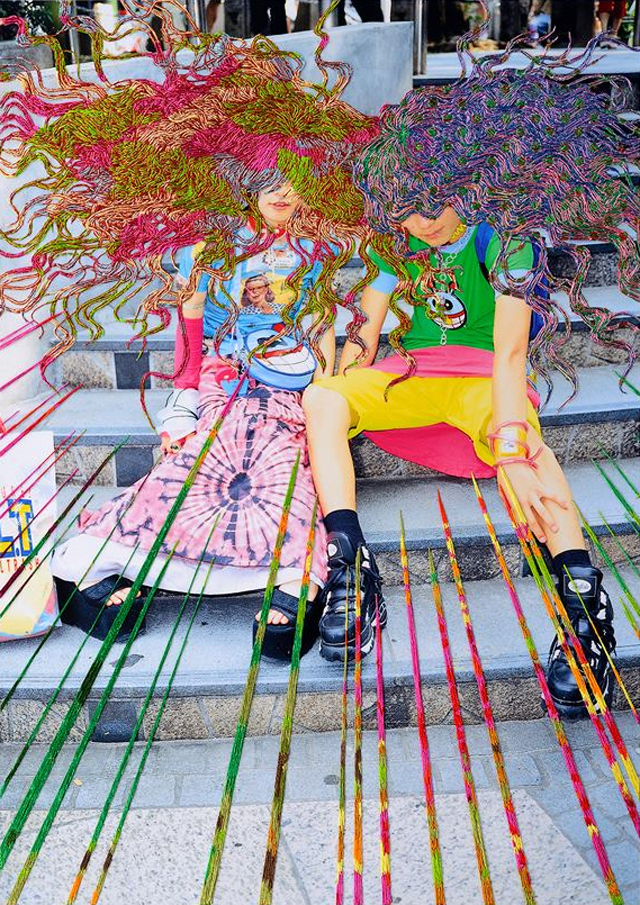
©asamikiyokawa
Title: TOKYO MONSTER Date: 2016
PUBLICATION
出版物
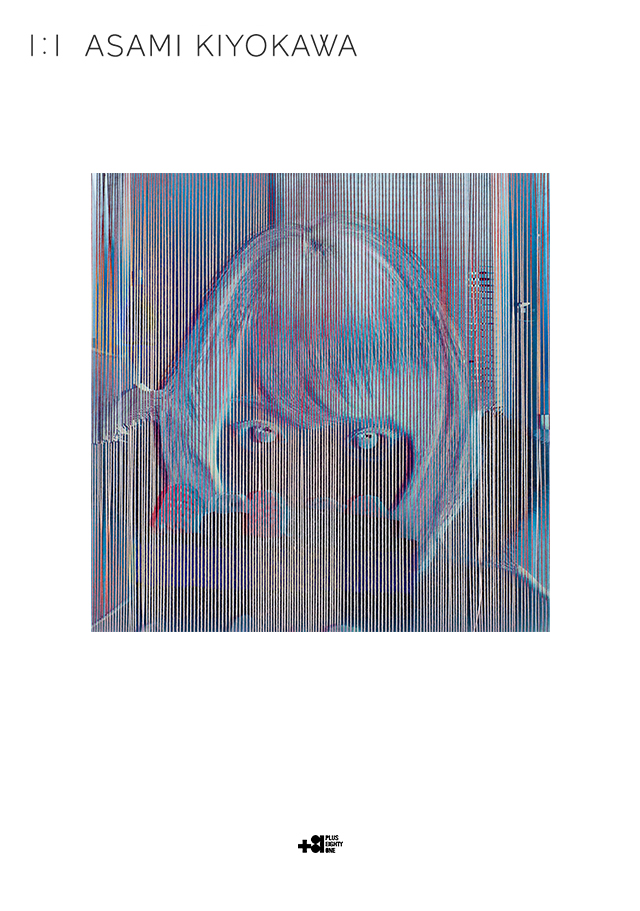
ARTIST PROFILE
作家について
清川あさみ
淡路島生まれ。2001年初個展。2003年より写真に刺繍を施す手法を用いた作品制作を開始。庭園美術館、水戸芸術館での単独個展など展覧会多数。代表作に美女採集、高橋コレクションに所蔵されている 「Complex」 シリーズがある。 「銀河鉄道の夜」 「狼王ロボ」などの絵本や 「caico」 「ひみつ」などの作品集など著書も多数あり、作家谷川俊太郎氏との共作絵本 「かみさまはいるいない?」が2年に1度の児童書の世界大会の日本代表作品に選ばれる。VOCA展入賞。各方面にて活躍の場を広げている。
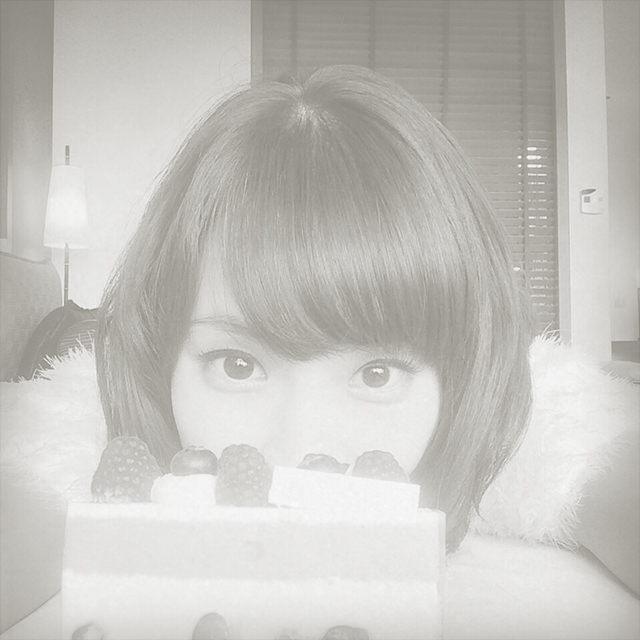
PRESS CONTACT
お問い合わせ
HIRAO INC.
東京都渋谷区神宮前 1-11-11 #608
Tel:03-5771-8808 Fax:03-5410-8858
担当:御船誠
mifune@hirao-inc.com
「 1 : 1 」のこと
海と山、星々の煌きがいつも近くにある、自然いっぱいの淡路島で生まれ育ち、19歳になった頃、ファッションを学ぶために上京しました。東京で服飾の専門学校に通いながら、「糸」という素材に向き合いました。
糸は日常の様々な場面に現れます。それは書物を綴じ、刺繍をするとどんな所にでもイメージが現れます。編み込んだり、織ったりすることで布や織物になり、私たちが日々身に纏う衣服をつくります。そんな「糸」の力に魅了されました。
その頃の私にとって、東京は人やものや情報が集まるだけでなく、自分自身が表現する立場になる可能性に満ちた場所でした。上京したその日、原宿で偶然スカウトされて始まった女性誌のモデルのお仕事もそのひとつでした。
モデルをしながら、私は写真というメディアに興味を持ちました。単にカメラマンとモデルがいて写真があるのではなく、被写体の外面と内面の関係において、深層心理や社会状況がどのように影響するのか?ということが知りたくなりました。ファッション誌が扱う商業写真が「表」だとすると、「裏」に隠れたモデル自身の心の奥に興味が湧きました。
例えば、誰もが持っているコンプレックス。私はファッションモデルにしては背が小さく、全ての服を自分で工夫して着こなす必要がありました。自分が誌面に登場する時も、一見堂々と振舞っているように見えても、内面にはさまざまな葛藤を抱えていたりするのです。そうした違和感を覚えながらも、段々と自分のコンプレックスがオリジナリティとなり、長所となり得るのだと感じるようになりました。
しばらくすると、自分で服を選び、掲載ページの中身を企画したり、プロデュースするようになりました。また、自分と同じ境遇のモデルを撮影して、その外見から想像される内面のイメージを刺繍で描いてみたいとも思いました。写真に針を刺し、糸を通して縫う行為は、まさに表と裏を行き来することなのです。撮影される側だった私が、撮影する側に回るのと同じように。
セレブリティのパーソナリティに合わせた装いを作り、撮影したポートレイトに刺繍をする「美女採集」シリーズや「コンプレックス」シリーズはこのようにして生まれました。
最近作の「1:1」は、私のインスタグラムに保存された画像をモチーフにしています。携帯で撮った画像を見返すと、その時の気持ちやその場の光景が思い出されます。どんな画像でも、世の中にほんの少しの影響があるのかも知れない、そんな風にも思いながら、フワフワとそこに寄り添いながら画像や言葉が選ばれていきます。
SNSのコミュニティはたくさんの見方があります。そこに流れる日常的な光景が何層ものレイヤーでできているようにさえ感じます。実際、溢れる情報の中にはホントもウソも混ざっているでしょう。
そのような実感をもとに、画像のネガポジを反転させ、片方のイメージは写真紙に、もう片方は縦糸だけを連ねた面に転写して、二つのレイヤーを少し離して重ね合わせます。そうすると、見る角度によって、ネガティヴとポジティヴのイメージが視覚のなかで競い合い、私の記憶や心理の背景にあるものが複層的に表現されます。
そのようなレイヤーはいつも何かの本質(コンプレックス)を隠す衣服のように、日々私たちの身体にまとわりつき、それぞれの個性に合わせた形で存在しています。それは単純ではないからこそ美しいのです。
とても複雑に見えるこの世界でも、たった一本の「糸」が、大切ななにかを繋ぎ、結ぶことがあります。そして「糸と糸」は、互いの心や感覚をつなげて、それぞれの記憶を編み込みながら、私たちの物語を紡いでいくのです。
2016年2月
About “1 : 1”
Amidst full of nature; close to the ocean and the mountains along the gleam of the stars, I grew up in the island of Awaji – and when I was nineteen I came to Tokyo to study fashion. It was while attending fashion school, where I first faced the material “thread.”
Thread appears in various scenes of life. It binds books and through embroidering images can appear anywhere. By knitting or weaving, thread becomes fabric and textile that form the clothes that we wear everyday. I was charmed by such a capacity of “thread.”
For me at the time, Tokyo was not only a place where people, things, and information gather, but also a place full of possibility; a place to occupy the position of creator and express myself. On the very first day I came to Tokyo, I was scouted in Harajuku by chance to be a model for a women’s fashion magazine. It was one of those instances allowing me to express myself.
While modeling I came to be interested in photography as a media. Photography isn’t simply a photographer and the subject – instead I wanted to know how the unconscious mind and the social conditions within the subject’s relation between the exterior and interior affect the result. If commercial photography which fashion magazines show is the “cover,” I became fascinated with the model’s own deep psyche which is hidden in the “back.”
For example, everyone has something about themselves they don’t feel good about. I’m short for a fashion model, so I had to devise every article of clothing by myself. When I appear on the pages of the magazines, even though I may look as though I am completely confident, I hold many internal conflicts. While experiencing such discomfort, I gradually started to feel as though such a complex became my own uniqueness and could be my strength.
After awhile, I began to choose my own clothes, planned the content of the story, and began producing the pages myself. Through photographing models in similar circumstance as myself, I thought about drawing the internal image with embroidery, envisioned from the external appearance. Piercing the photograph with needle; the act of sewing with thread is literally to go back and forth between the surface and the back. This is also similar to the way I turned to be the one to photograph from the position of being photographed.
Through creating dresses that fit the celebrities’ personalities and embroidering the portraits I photograph, the series “Bijo-Saishu” and “Complex” were created.
The recent series “1:1” takes the images saved in my Instagram as the motif. When I look at the photographs I took with my cell phone, I’m reminded of the particular feeling and the image of the place. Perhaps every image has some effect on the world, regardless of what it is. While thinking along those lines, I lightly tread beside the images and the texts to choose them.
There are many perspectives on the communities of social media. The images of the everyday sights that run through it could feel as if they are composed of several layers. In reality, among the overflowing information, both truths and lies are fused and exist together.
From these sentiments, the negative and the positive are reversed, and one of the images is printed on photographic paper, while the other is transferred onto the surface where only the warp threads are lined. The two layers are superimposed on top of each other with slight gap between them. Because of this, depending on the angle of viewing, the negative and the positive images compete in vision and represent my memory and the scenes of my psyche in multiple layers.
Every day, these layers cling to our bodies just like the clothes that hide some kind of essence (the complex), and exist in the shape tailored to each one’s individuality. And it is beautiful because it is complex.
Although the world seems so complicated just one “thread” binds and ties something precious. And the “threads” connect our minds and senses while weaving our memories and spinning our stories.
February 2016

 instagram
instagram